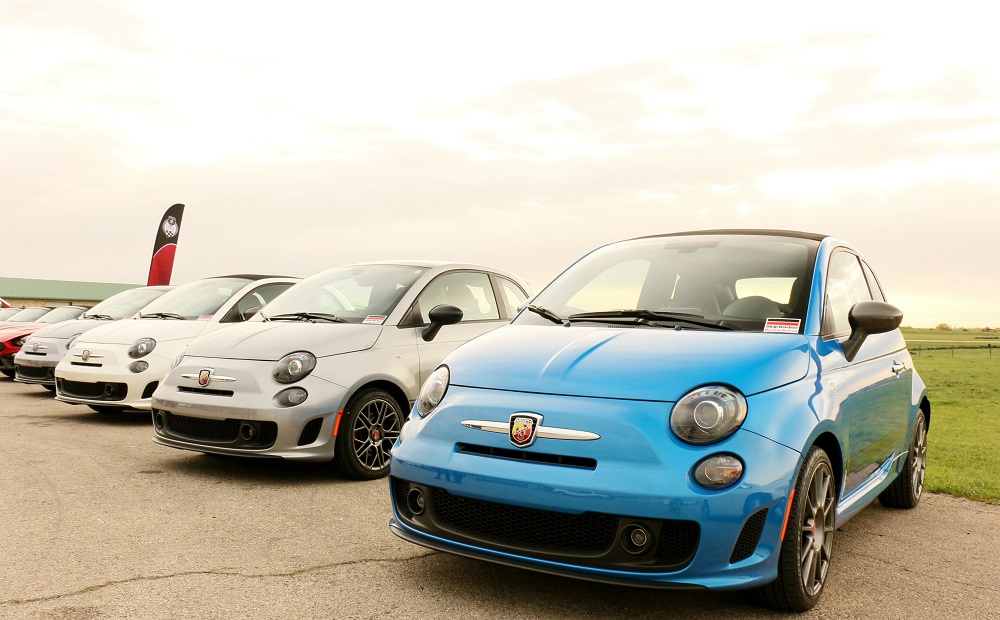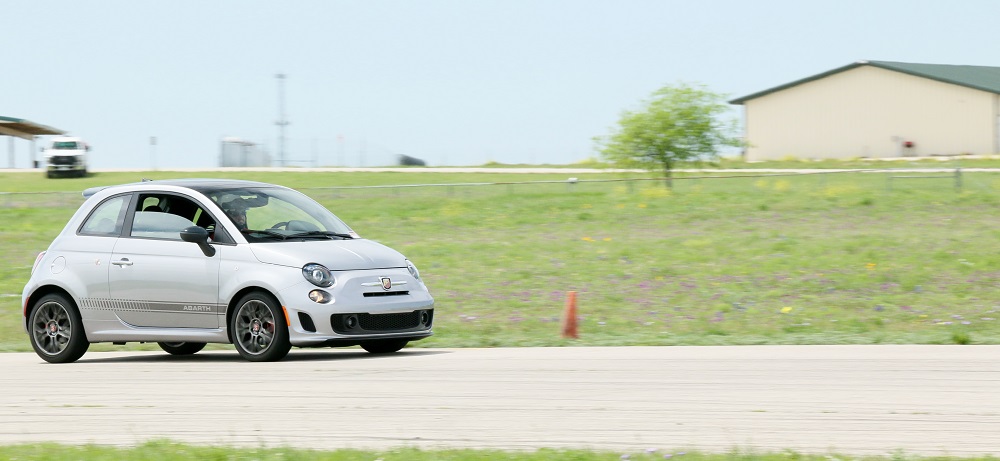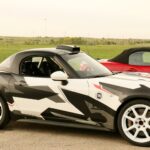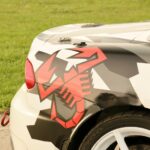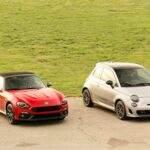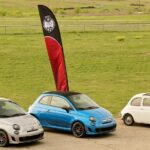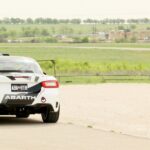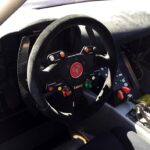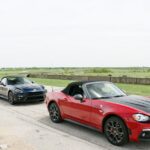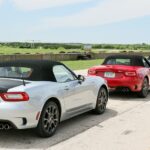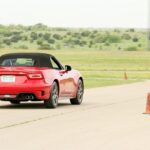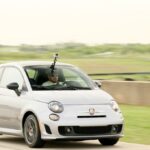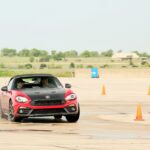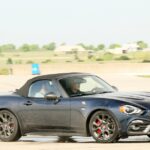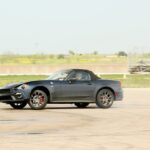Track Time in Fiat’s Abarth Performance Models, Part I
With help from Skip Barber Racing School, I learned more about vehicle dynamics in the Fiat 500 Abarth and 124 Spider Abarth.
How do you say, “Just for the fun of it” in Italian? A few weeks ago, I got an email from an FCA representative asking me if I would like to drive the Abarth performance versions of the Fiat 500 and 124 Spider on a track with the expert guidance of Skip Barber Racing School instructors. I couldn’t think of any typical reason for it. Fiat wasn’t launching new generations of either one of those cars. The event wasn’t a lead-up to the debut of another model. It was just as simple and fun as it sounds. Questo è tutto. Of course I said yes.
I took the mostly scenic route from Austin, Texas, to the Motorsport Ranch, “a country club for motoring enthusiasts” with 1.3- and 1.7-mile road courses, in Cresson, near Fort Worth. The day started with an introductory class on vehicle dynamics and driving strategies run by one of Skip Barber’s lead instructors, F2000 champion Jean-Sebastien Sauriol. Fiat already had the cars ready to go. I paid attention to what Sauriol said to make sure I was as prepared as possible for the track, too. These were my biggest takeaways from Sauriol’s drivers clinic:
- Take a Seat and Do It Well. Position yourself so that you can fully depress the pedals without locking your knees. Grab the wheel with both hands. Forget 10 and two. Think nine and three. And be close enough to the wheel that there’s a slight bend in your elbows and you can rest your wrists at the 12 o’clock position. According to Sauriol, many drivers lose control of their car because they’re seated too far back.
- Back, Not Butt. Have you ever heard the term “butt dyno?” Some people use it to describe the device they use to tell how fast a car is. Don’t use that as a gauge out on the track. Instead, use your back. That’s what will give you the best idea of what your car is doing. If you’re positioned in your seat correctly, you should be able to keep your back flat against it while turning the wheel 180 degrees.
- The Dead Pedal is Not Just a Footrest. Use it to brace yourself when taking a hard curve.
- Your Eyes Will Take You There. They guide your hands and feet. Keep your eyes up and pointed ahead. Whatever they lock onto is what you and the car will head toward.
- A Balancing Act. A tire’s contact patch and the grip it can provide is directly affected by the weight and the demands put on it. When you accelerate in a front-engined car, the front contact patches have less weight on them, so they can’t provide as much traction as those in the rear. The opposite happens when you brake. Corners can place the majority of the car’s weight over one tire.
- Understeer, Schmundersteer. Understeer, aka push, is the easiest thing to cure. Want less of it? Back off the throttle so the car’s weight shifts to the front end.
- CPR. Oversteer is a little more complicated. Luckily, there’s a three-step process for combating it: CPR. The “C” is for “correct.” If your car starts to slide, make sure you’re looking where you want it to go, ease off the gas, then move your hands quickly to steer into the skid. “P” is for “pause.” Wait to see if the car stops rotating before inputting another correction to avoid making it swing back and forth like a pendulum. If you’ve made the right moves, then you enter the “R” phase: “recover.” Straighten the wheel, then keep going.
Miniscule Car, Minimal Changes
Then it was time to go outside and get more familiar with the 500 and 124 Spider Abarths we would be driving. Unfortunately, we could only ride shotgun for hot laps in the leaded-race-gas-fueled 124 rally car.
Regular 500s get revised hardware, but Abarths carry on unchanged. Power comes from a turbocharged 1.4-liter MultiAir four-cylinder engine. That’s connected to either a five-speed manual or six-speed automatic gearbox. In stick-shift Abarths, the four-banger generates 160 horsepower and 170 lb.-ft of torque. Auto Abarths get a little less horsepower (157), but significantly more torque (183).
Both models transmit their power to the road through their standard 195/45R16XL all-season tires or optional 205/40R17XL front tires. That rubber stays connected to the road thanks to a MacPherson suspension with KONI frequency selective damping twin-tube struts up front and a twist-beam axle with coil springs and twin-tube shocks in the back.
Out on the Track
My fellow writers and I were going to use the Abarths to complete three exercises: Autocross, skid pad, and lead/follow laps around the Motorsport ranch’s 11 turn, 1.7 mile course. We were split into two groups; mine was first up to complete the autocross portion. It was a short, tight course with a compact straightaway, a slalom section, and a sharp hairpin turn. I started with a 500 Abarth.
If I gave the 500 Abarth enough throttle in a turn, I could feel it loosen up and get more playful. …It had enough power to make the straightaways fun and its brakes were well matched to the power they had to counteract.
Every rapid transition I made increased my awareness of how tall the 500 Abarth is relative to its length. Fortunately, it doesn’t take up a lot of horizontal space. The 500 Abarth is 12 feet long and has a 7.5-foot wheelbase. Those dimensions made its extremities easy to keep track of at speed. Once I became more familiar with the layout of the course, I grew more confident. I didn’t have to think about navigating as much, so I could concentrate more on my steering. The once-daunting hairpin became just another dance step for the light-footed Italian whose short wheelbase made it easy to bend it around the pivot point.
Each lap revealed more things to like about the 500 Abarth. For such a small car, it had a big personality. Its loud, guttural exhaust note made it seem even larger. It was a lively little thing. If I gave the 500 Abarth enough throttle in a turn, I could feel it loosen up and get more playful. The faster I went, the less I noticed its height. It had enough power to make the straightaways fun and its brakes were well matched to the power they had to counteract.
The 124 Spider Abarth was the only car allowed on the skid pad, but my colleagues and I were free to hit the main track in both Abarth models. For the final exercise of the day, I pulled on a head sock and helmet and headed toward the course. I jumped into a 500 Abarth first and followed some of my classmates (who were also in 500 Abarths) out onto the track. A Skip Barber instructor was at the head of the five-car group in a Dodge Challenger. He would lead us all through the course, which was spotted with cones that marked the entry, apex, and exit points of all 11 turns. We just had to do our best to follow his line and keep up.
The once-daunting hairpin became just another dance step for the light-footed Italian whose short wheelbase made it easy to bend it around the pivot point.
Trying to remember everything I was taught while trying to keep up with the 500 Abarth in front of me and not fly off the track was like using your hands to scoop water back into an overflowing bathtub. I had to keep reminding myself to look further down the track and focus on the next turn instead of the one I was about to enter. If I did that, I would forget about something else. It gave me a greater appreciation of just how much stamina and, perhaps more important, mental stamina race car drivers possess. They have to muscle a much faster car around a track for hours in stifling heat while trying to beat their rivals and cheat death.
I faced a physical challenge of my own behind the wheel of the 124 Spider Abarth. I’ll tell you more about it in Part 2, which you can find on Team Speed tomorrow. Until then, check out some more of the action from track day at Motorsport Ranch, below.
Photos for Team Speed by Derek Shiekhi
Join the Team Speed forums now!

